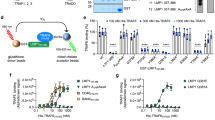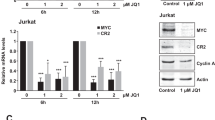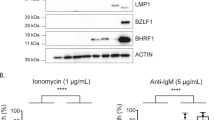Abstract
Epstein–Barr virus (EBV) is associated with several human malignancies including Burkitt’s lymphoma (BL), Hodgkin’s disease (HD) and nasopharyngeal carcinoma. A variety of cytokines and receptors have been described to be activated by EBV. Here we show that the IL-2 receptor (IL-2R) α-chain, which is weakly expressed on normal resting lymphoid cells, is activated by EBV. Comparison of EBV-negative BL cell lines and their EBV convertants showed an enhanced CD25 expression in EBV-positive BL cells. Transient expression of the oncogenic virus protein latent membrane protein-1 (LMP1) in L428 Hodgkin’s lymphoma cells and in Burkitt’s lymphoma cells (BL2, BL41, BL30) cells leads to enhanced CD25 expression. Both C-terminal activating regions (CTARs) of LMP1 are involved in CD25 activation. Inhibition of LMP1-mediated NFκB enhancement by a constitutive repressive form of IκB-α resulted in decreased CD25 surface expression, indicating that NFκB is involved in CD25 gene regulation. Furthermore, LMP1-mediated CD25 activation was associated with enhanced levels of the soluble form of CD25 (sCD25) in L428 Hodgkin’s lymphoma cells but not in BL cells. LMP1 associated enhanced expression of membrane CD25 and soluble CD25 may have immunomodulatory functions and could be involved in biology of EBV-associated diseases.
This is a preview of subscription content, access via your institution
Access options
Subscribe to this journal
Receive 6 digital issues and online access to articles
$119.00 per year
only $19.83 per issue
Buy this article
- Purchase on Springer Link
- Instant access to full article PDF
Prices may be subject to local taxes which are calculated during checkout
Similar content being viewed by others
References
Rickinson AB, Kieff E Epstein Barr virus. In: Fields BN, Knipe DM, Howley PM (eds) Fields Virology vol. 2 (edn 3) Lippincott-Raven: Philadelphia 1996 pp :2397–2446
Wang F, Gregory C, Sample C et al Epstein–Barr virus latent membrane protein (LMP1) and nuclear proteins 2 and 3C are effectors of phenotypic changes in B lymphocytes: EBNA-2 and LMP1 cooperatively induce CD23 J Virol 1990 64 2309–2318
Kaye KM, Izumi KM, Kieff E Epstein–Barr virus latent membrane protein 1 is essential for B-lymphocyte growth transformation Proc Natl Acad Sci USA 1993 90 9150–9154
Kulwichit W, Edwards RH, Davenport EM, Baskar JF, Godfrey V, Raab-Traub N Expression of the Epstein–Barr virus latent membrane protein 1 induces B cell lymphoma in transgenic mice Proc Natl Acad Sci USA 1998 95 11963–11968
Eliopoulos AG, Gallagher NJ, Blake SMS, Dawson CW, Young LS Activation of the p38 mitogen-activated protein kinase pathway by Epstein–Barr virus-encoded latent membrane protein 1 coregulates interleukin-6 and interleukin-8 production J Biol Chem 1999 274 16085–16096
Huen DS, Henderson SA, Croom CD, Rowe M The Epstein–Barr virus latent membrane protein-1 (LMP1) mediates activation of NF-kappa B and cell surface phenotype via two effector regions in its carboxy-terminal cytoplasmic domain Oncogene 1995 10 549–560
Kieser A, Kilger E, Gires O, Ueffing M, Kolch W, Hammerschmidt W Epstein–Barr virus latent membrane protein-1 triggers AP-1 activity via the c-Jun N-terminal kinase cascade EMBO J 1997 16 6478–6485
Gires O, Kohlhuber F, Kilger E et al Latent membrane protein 1 of Epstein–Barr virus interacts with JAK3 and activates STAT proteins EMBO J 1999 18 3064–3073
Vockerodt M, Haier B, Buttgereit P, Tesch H, Kube D The Epstein–Barr virus latent membrane protein 1 (LMP1) induces Interleukin-10 in Burkitt’s lymphoma cells but not in Hodgkin’s cells involving the p38/SAPK2 pathway Virology 2001 280 183–198
Mitchell T, Sudgen B Stimulation of NF-κB-mediated transcription by mutant derivatives of the latent membrane protein of EBV J Virol 1995 69 2968–2972
Floettmann JE, Rowe M Epstein–Barr virus latent membrane protein-1 (LMP1) C-terminus activation region 2 (CTAR2) maps to the far C-terminus and requires oligomerisation for NF-kappaB activation Oncogene 1997 15 1851–1858
Mosialos G, Birkenbach M, Yalamanchili R, Van AT, Ware C, Kieff E The Epstein–Barr virus transforming protein LMP1 engages signaling proteins for the tumor necrosis factor receptor family Cell 1995 80 389–399
Kaye KM, Devergne O, Harada JN et al Tumor necrosis factor receptor associated factor 2 is a mediator of NF-kappaB activation by latent infection membrane protein 1, the Epstein–Barr virus transforming protein Proc Natl Acad Sci USA 1996 93 11085–11090
Izumi KM, Kaye KM, Kieff ED The Epstein–Barr virus LMP1 amino acid sequence that engages tumor necrosis factor receptor associated factors is critical for primary B lymphocyte growth transformation Proc Natl Acad Sci USA 1997 94 1447–1452
Izumi KM, Kieff ED The Epstein–Barr virus oncogene product latent membrane protein 1 engages the tumor necrosis factor receptor-associated death domain protein to mediate B lymphocyte growth transformation and activate NF-kappaB Proc Natl Acad Sci USA 1997 94 12592–12597
Hatzivassiliou E, Miller WE, Raab TN, Kieff E, Mosialos G A fusion of the EBV latent membrane protein-1 (LMP1) transmembrane domains to the CD40 cytoplasmic domain is similar to LMP1 in constitutive activation of epidermal growth factor receptor expression, nuclear factor-kappaB, and stress-activated protein kinase J Immunol 1998 160 1116–1121
Devergne O, McFarland EC, Mosialos G, Izumi KM, Ware CF, Kieff E Role of the TRAF binding site and NF-kappaB activation in Epstein–Barr virus latent membrane protein 1-induced cell gene expression J Virol 1998 72 7900–7908
Nakagomi H, Dolcetti R, Bejarano MT, Pisa P, Kiessling R, Masucci MG The Epstein–Barr virus latent membrane protein-1 (LMP1) induces interleukin-10 production in Burkitt lymphoma lines Int J Cancer 1994 57 240–244
Eliopoulos AG, Stack M, Dawson CW et al Epstein–Barr virus-encoded LMP1 and CD40 mediate IL-6 production in epithelial cells via an NF-kappaB pathway involving TNF receptor-associated factors Oncogene 1997 14 2899–2916
Klein SC, Kube D, Abts H, Diehl V, Tesch H Promotion of IL8, IL10, TNFalpha and TNFbeta production by EBV infection Leuk Res 1996 20 633–636
Herbst H, Foss HD, Samol J et al Frequent expression of interleukin-10 by Epstein–Barr virus-harboring tumor cells of Hodgkin’s disease Blood 1996 87 2918–2929
Kube D, Laser H, von Knethen A, Tesch H The AT-rich region between −54 to −66 is important for the promoter activity of interleukin-10 in Epstein–Barr virus positive Burkitt’s lymphoma cells Genes Immun 1999 1 105–114
Cahir-McFarland ED, Davidson DM, Schauer SL, Duong J, Kieff E NF-kappa B inhibition causes spontaneous apoptosis in Epstein–Barr virus-transformed lymphoblastoid cells Proc Natl Acad Sci USA 2000 97 6055–6060
Mehl AM, Floettmann JE, Jones M, Brennan P, Rowe M Characterization of intercellular adhesion molecule-1 regulation by Epstein–Barr virus-encoded latent membrane protein-1 identifies pathways that cooperate with nuclear factor kappa B to activate transcription J Biol Chem 2001 276 984–992
Tan TH, Huang GP, Sica A et al Kappa B site-dependent activation of the interleukin-2 receptor alpha-chain gene promoter by human c-Rel Mol Cell Biol 1992 12 4067–4075
Liou HC, Jin Z, Tumang J, Andjelic S, Smith KA, Liou ML c-Rel is crucial for lymphocyte proliferation but dispensable for T cell effector function Int Immunol 1999 11 361–371
Tesch H, Hermann T, Abts H et al High affinity IL-2 receptor on a Hodgkin’s derived cell line Leuk Res 1990 14 953–960
Kube D, Vockerodt M, Weber O et al Expression of Epstein–Barr virus nuclear antigen I is associated with enhanced expression of CD25 in the Hodgkin cell line L428 J Virol 1999 73 1630–1636
Jarrett AF, Armstrong AA, Alexander E Epidemiology of EBV and Hodgkin’s lymphoma Ann Oncol 1996 7 5–10
Kube D, Vockerodt M Transient gene expression and MACS enrichment. In: Wilson JB (ed) Epstein Barr Virus Protocols. Methods in Molecular Biology Humana: Totowa 2001 pp 155–164
Floettmann JE, Eliopoulos AG, Jones M, Young LS, Rowe M Epstein–Barr virus latent membrane protein-1 (LMP1) signalling is distinct from CD40 and involves physical cooperation of its two C-terminus functional regions Oncogene 1998 17 2383–2392
Bargou RC, Emmerich F, Krappmann D et al Constitutive NFκB-RelA activation is required for proliferation and survival of Hodgkin disease tumor cells J Clin Invest 1997 100 2961–2974
Wood KM, Roff M, Hay R Defective IκBα in Hodgkin cell lines with constitutively active NF- Oncogene 1998 16 2131–2139
Kube D, Holtick U, Vockerodt M et al STAT3 is constitutively activated in Hodgkin cell lines Blood 2001 98 762–770
Gause A, Roschansky V, Tscjiersch A et al Low serum IL-2 receptor levels correlate with a good prognosis in patients with Hodgkin’s lymphoma Ann Oncol 1991 2 43–47
Enblad G, Sundstrom C, Gronowitz S, Glimelius B Serum levels of interleukin-2 receptor (CD 25) in patients with Hodgkin’s disease, with special reference to age and prognosis Ann Oncol 1995 6 65–70
Klein SC, Jücker M, Abts H, Tesch H IL6 and IL6 receptor expression in Burkitt’s lymphoma and lymphoblastoid cell lines: promotion of IL6 receptor expression by EBV Hematol Oncol 1995 13 121–130
Waldmann TA, Goldman CK, Robb RJ et al Expression of interleukin 2 receptors on activated human B cells J Exp Med 1984 160 1450–1466
de Totero D, Francia di Celle P, Cignetti A, Foa R The IL-2 receptor complex: expression and function on normal and leukemic B cells Leukemia 1995 9 1425–1431
Waldmann TA The structure, function, and expression of interleukin-2 receptors on normal and malignant lymphocytes Science 1986 232 727–732
Crenon I, Beraud C, Simard P, Montagne J, Veschambre P, Jalinot P The transcriptionally active factors mediating the effect of the HTLV-I Tax transactivator on the IL-2R alpha kappa B enhancer include the product of the c-rel proto-oncogene Oncogene 1993 8 867–875
Wolf BC, Martin AW, Neiman RS et al The detection of Epstein–Barr virus in hairy cell leukemia cells by in situ hybridization Am J Pathol 1990 136 717–723
Tsilivakos V, Tsapis A, Kakolyris S, Iliakis P, Perraki M, Georgoulias V Characterization of interleukin 2 receptors on B-cell chronic lymphocytic leukemia cells Leukemia 1994 8 1571–1578
Tesch H, Günther A, Abts H et al Expression of interleukin-2Rα and interleukin-2β in Hodgkin’s disease Am J Pathol 1993 142 1714–1720
Pimentel-Muinos FX, Mazana J, Fresno M Regulation of interleukin-2 receptor alpha chain expression and nuclear factor.kappa B activation by protein kinase C in T lymphocytes. Autocrine role of tumor necrosis factor alpha J Biol Chem 1994 269 24424–24429
John S, Reeves R, Liu J, Child R et al Regulation of cell-type specific IL-2R expression. Potential role of interactions between Elf-1, HMD-I(Y) and NFκB Mol Cell Biol 1995 15 1786–1792
Kilger E, Kieser A, Baumann M, Hammerschmidt W Epstein–Barr virus-mediated B-cell proliferation is dependent upon latent membrane protein 1, which simulates an activated CD40 receptor EMBO J 1998 17 1700–1709
Burlinson EL, Graber P, Bonnefoy JY, Ozanne BW, Cushley W Soluble CD40 ligand induces expression of CD25 and CD23 in resting human tonsillar B lymphocytes Eur J Immunol 1996 26 1069–1073
Herbst H, Steinbrecher E, Niedobitek G et al Distribution and phenotype of Epstein–Barr virus-harboring cells in Hodgkin’s disease Blood 1992 80 484–491
Gorschluter M, Bohlen H, Hasenclever D, Diehl V, Tesch H Serum cytokine levels correlate with clinical parameters in Hodgkin’s disease Ann Oncol 1995 6 477–482
Burton J, Kay NE Does IL-2 receptor expression and secretion in chronic B-cell leukemia have a role in down-regulation of the immune system? Leukemia 1994 8 92–96
Eicher DM, Waldmann TA IL-2R alpha on one cell can present IL-2 to IL-2R beta/gmma(c) on another cell to augment IL-2 signaling J Immunol 1998 161 5430–5437
Rickinson AB, Moss DJ Human cytotoxic T lymphocyte responses to Epstein–Barr virus infection Annu Rev Immunol 1997 15 405–431
Acknowledgements
We thank Dr Sigrun Smola for critical reading of the manuscript.
Author information
Authors and Affiliations
Corresponding author
Additional information
This work was supported by grants from the Deutsche Forschungsgemeinschaft (SFB502/P5 and KU954/4–1).
Rights and permissions
About this article
Cite this article
Vockerodt, M., Tesch, H. & Kube, D. Epstein–Barr virus latent membrane protein-1 activates CD25 expression in lymphoma cells involving the NFκB pathway. Genes Immun 2, 433–441 (2001). https://doi.org/10.1038/sj.gene.6363803
Published:
Issue Date:
DOI: https://doi.org/10.1038/sj.gene.6363803
Keywords
This article is cited by
-
WNT5A: a motility-promoting factor in Hodgkin lymphoma
Oncogene (2017)
-
Microenvironmental interactions between endothelial and lymphoma cells: a role for the canonical WNT pathway in Hodgkin lymphoma
Leukemia (2017)
-
Epstein–Barr Virus-Positive Diffuse Large B cell Lymphoma in the Experience of a Tertiary Medical Center in Poland
Archivum Immunologiae et Therapiae Experimentalis (2016)
-
Specific tumor-stroma interactions of EBV-positive Burkitt's lymphoma cells in the chick chorioallantoic membrane
Vascular Cell (2012)



